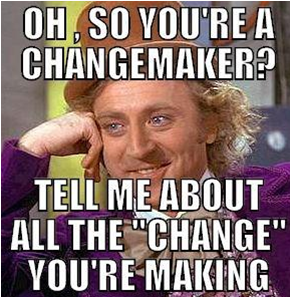Why Real Changemakers Are On Another Level
Matthew Owen, April ’16 Associate, reflects on change-making and on the potential of and challenges for the social enterprise sector to contribute to positive social change.

I worry that the generation of young adults raised on the Internet, myself included, aren’t the best at making social change happen. Perhaps we haven’t come to terms with the uncomfortable truth that firing off an impassioned status into our social media echo chambers doesn’t actually get anything done. Watch me fire off this impassioned article into my social media echo chamber to prove my point.
Changemaking in action
My own changemaking impotence really hit home upon meeting Ed Fidoe, once a star of 90s kids TV shows Woof! and Founder of the 21 Trust. After a youth spent canine shape-shifting and having worked to pioneer new approaches to education, Ed would be fully justified in whacking changemaker right at the top of his CV.

Ed Fideo: Also a full-time changemaker
Ed’s initial motivation was his dissatisfaction with British educational policy, notably the failure to appropriately reward spoken language and creativity and the belittlement of vocational and technical skills (despite all these skills massively enhancing employability). At its root, this was a personal beef, borne out of years of producing schoolwork that had no broader value than fitting into a narrow attainment band. Sound familiar?
In response, he visited and researched innovative schools around the world, which challenge pupils to question their curriculum and commit themselves to projects that can benefit their communities. Then he co-founded School21 in Newham, a school for 4–18 year olds that teaches about the importance of attributes like eloquence, professionalism and craftsmanship. He worked to develop projects that promote oracy (speaking skills) in schools and that support teachers in deprived areas to get their pupils asking questions and creating work that can make a difference in the world.
I was inspired and challenged by Ed’s work and not only because he was a child actor who hadn’t skipped merrily down the path to prescription drug addiction. I was inspired and challenged because he’d built up a vision and made it happen. I however, had not. I was similarly dissatisfied about a lot of my work at school. On top of that, I’d taught in schools for five years, accumulating some serious rage about arbitrary assessment criteria limiting how and what we teach children. But, in true millennial-style, I’d only really whinged about it. I might even have fired off a bellicose Facebook status or two. I had the requisite fire in the belly, but had barely started to think about alternatives, let alone put some ideas into practice.
The levels of changemaking
I’m not going to don a hair shirt and bemoan myself for failing to re-write the national curriculum as a trainee teacher. GCSE results were putting beans on my toast. My single, perhaps glaringly obvious, reflection is simply this — there are levels to this changemaking lark. Level 1 is a recognition that “it’s not right that…”. Level 2 is a vision that “maybe this would be better…”. Level 3 is a practical response, “look what we’ve done about it…”. It’s easy to be dissatisfied with the status quo, harder to think of a viable alternative and harder still to put the alternative into practice. And finally, there’s Level 4, the ultimate end goal — to create lasting change on the largest appropriate scale. This is the difference between changing a handful of schools and changing the context in which all schools operate. Level 4 is about creating a new norm, not a set of positive outliers.

‘Hillary is the best darn changemaker I’ve ever met in my entire life” (Bill Clinton, 2016)
Releasing the potential of social enterprise
Social enterprise is one way of moving up the changemaking levels, but just like my generation, I fear the sector isn’t living up to its potential. Again, I’m not going to wail and gnash my teeth. Social enterprise is a young movement and there are lots of organisations out there harnessing a passion to do things differently, working towards a fresh vision and getting results. And we can show this to be the case. Credible social impact measurement, couched within a convincing theory of change, is the badge of honour for good social enterprises. It’s proof that an enterprise has reached Level 3, that it’s done something that has made a difference.
So what’s holding back the sector from achieving greater prominence and stopping more social enterprises reaching Level 4? I’ve heard it said that what we’re lacking is the social enterprise Google, an organisation that can raise the profile of the sector globally. That would certainly help. But I think there’s a more foundational problem: how difficult it is for small social enterprises to scale up effectively. Scaling a business model is difficult enough. Scaling a business model to, for example, reduce reoffending in multiple cities requires an additional understanding of the drivers of social problems in particular places, resting on a far greater number of significant assumptions.
Gaps in funding and investment
It’s clear that scaling small social enterprises isn’t difficult only because of the complexity of social problems. Significant gaps in social funding and investment are preventing organisations with a scale-up plan from putting the plan into action. Just as start-ups often require a cash injection to get up and running, scaling organisations may only be able to transition to larger scale operations with a grant or loan.
The growth of the social investment market could help to meet this need, but social investment just isn’t accessible to small organisations that don’t have the capacity to manage an investment, test different business models and create new partnerships, products or services.
In the current climate, grant funding is the predominant means to accelerate the growth of small enterprises. The problem is that funding is most easily accessible to social start-ups or established social enterprises, but there are very few grants available in the £250k — £1m range. Social funders are understandably reluctant to provide these sorts of sums to organisations that lack assets and are not sufficiently stable, unless there’s very clear evidence that a scaled-up enterprise is likely to proportionately improve its impact. This funding gap traps small, ambitious social enterprises in a vicious cycle: they cannot attract funding due to not being sufficiently established, but struggle to establish themselves because of a lack of funding. The funding gap is also self-sustaining: a lack of funding to support enterprises to scale means that fewer scale successfully. This serves to discourage funding in this area, reinforcing a risk-averse funding culture that undermines growth.
Innovative responses are needed if the small social enterprises are going to grow in spite of a lack of attainable social investment, an adverse funding climate and inherent complexity of scaling for impact.

White Goodman, ideal role model for risk-averse social funders everywhere: “that’s me taking the bull horns. It’s a metaphor. But that really happened though.”
Social investment and funding: the case for more nurturing relationships
If social investment is going to grow the social enterprise sector, then the gap in the type of investment available to small and large organisations needs to narrow. There is a role for social investment funds to support organisations to build readiness to take on repayable finance. The City Bridge Trust’s Stepping Stones Fund is developing this sort of model. The Fund provides human, financial and strategic support whilst accompanying organisations as they move through 3 key stages towards social investment readiness: capacity building, piloting better outcomes and risk finance.
As social investment is currently beyond the reach of most small social enterprises, a reconfigured relationship with social funders is sorely needed. Movement is needed on both sides. Social funders need to move to narrow the funding gap by working to provide targeted support to small but ambitious social enterprises that lack the required expertise to effectively gauge how to grow. In turn, enterprises will need to be open to funding approaches that require collaboration with funders and other funded organisations to develop scaling expertise. Such approaches would make participation in collaborative networks a condition for the receipt of funding.
The Big Lottery Fund’s Accelerating Ideas Fund is piloting a funding approach that prioritises shared learning. The Fund requires its applicants to have a track record of tackling challenges associated with the ageing population. Funding is then used to help organisations prepare to scale. Funded organisations don’t necessarily start with a fully tested theory of change or a fully costed strategy, but are connected with external experts and other funded organisations at different stages of the scaling process. The Fund is even willing to support organisations to develop or refine their processes before a formal application has been made.
Funding to embed scaling methodologies in small enterprises could be most transformative in shaking up risk-averse funding culture. If social enterprises were equipped to convincingly test new business models and to forecast the potential for increased social impact (in similar ways to commercial growth forecasting) then funders may be able to work with greater confidence to support small organisations.
The short case for social enterprises as ‘learning organisations’
Given the difficulties of scaling small social enterprises in the current climate, we can learn a lot from enterprises that have been able to grow. One successful model employed by such social enterprises is to operate as learning organisations. This simply means that by allowing in-house innovation, learning and improvement, organisations can easily adopt new approaches or adapt existing ones.
In future posts on Show Me The Impact, I’m going to focus on specific social enterprises that have grown by operating as learning organisations. The term learning organisation comes close to obscuring all that’s exciting about this professional culture in a fuzz of soul-destroying management speak, but ultimately, this whole approach is a means of ensuring that social enterprises get to Level 4 and achieve widespread social change. And isn’t that the reason we got into this social enterprise game in the first place?
